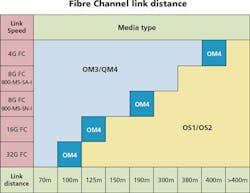Next-generation Fibre Channel speeds demand high-performance cabling
By Patrick McLaughlin
Fibre Channel, the protocol that has served storage networks for decades and is as vital as ever to modern computing environments, continues to demand every bit as much performance out of a cabling infrastructure as do the Ethernet variants that are prominent in data center local area networks. Today 32- and 128-Gbit/sec speeds are in focus for Fibre Channel.
Fibre Channel specifications are produced by the International Committee for Information Technology Standards (INCITS; www.incits.org) and, in particular, that organization’s T11 Fibre Channel Interfaces committee/T11.2 Physical Variants Task Group. The Fibre Channel Industry Association (FCIA; www.fibrechannel.org) is a separate organization from INCITS, but the FCIA group produces much of the publicly available information about Fibre Channel technology and standards development.
In February 2014 the FCIA announced the coming of what is dubbed Gen 6 Fibre Channel-the technology’s sixth generation of speed and capability. At that time the FCIA explained that Gen 6 Fibre Channel represented “the industry’s fastest industry standard networking protocol that enables storage area networks (SANs) of up to 128GFC.
“Gen 6 Fibre Channel is the next generation of Fibre Channel designed to address performance, reliability, and scalability requirements for hyperscale virtualization, SSD storage technology, and new data center architectures,” the FCIA continued. “Solutions are expected to be broadly available in 2016. Gen 6 doubles the 16GFC data throughput of 3,200 Megabits per second to 32GFC, which enables 6400 Mbits/sec full-duplex speeds. Gen 6 also provides an option to quadruple 32 GFC to 128 GFC throughput, thereby achieving full-duplex speeds of 25,600 Mbits/sec based upon the seamless inter- and backward-compatibility of Fibre Channel technology.”
At BICSI’s (www.bicsi.org) Canadian Conference in April 2015, OFS (www.ofsoptics.com) senior manager John Kamino delivered a presentation titled “What’s Next in Fiber Optic Data Communications?” in which he provided updates on INCITS T11 activities related to Gen 6 Fibre Channel. Kamino explained that the ad-hoc group within T11.2 had completed its work on 32G Fibre Channel, and that the protocol is indeed backward-compatible to Fibre Channel’s 8 and 16G iterations.
Concerning the optical media that can support Gen 6 speeds, Kamino said Om2 multimode can support distances up to 20 meters; Om3 multimode can support up to70 meters; and Om4 can support a reach of 100 meters. Singlemode fiber can support 10-kilometer distances of 32GFC.
Work on 128GFC had not progressed as far, Kamino reported. As of springtime, there was no breakout to 32 and 16GFC, which means no backward-compatibility with those speeds. As for reach, T11 was at that time working with reach objectives as opposed to established distances. Those objectives included 60 meters on Om3 with 1.5dB connector loss, and 70 meters with 1.0dB connector loss. For Om4, the objective was 85 meters on Om4 with 1.5dB connector loss and 100 meters with 1.0dB loss. Objectives for singlemode media were 500 meters using PSm4 optics and 2 kilometers using wave-division multiplexing optics.
Kamino also reported that INCITS had undertaken initial efforts toward an even higher speed version of Fibre Channel, this one with speeds of 64/256 Gbits/sec. The expectation is that the 64/256 specification will be backward-compatible with 32GFC and 16GFC. Kamino noted that initial reach objectives for 64/256GFC were 100 meters over Om4 multimode. For singlemode, the objectives were 10 km for 64GFC and 2km for 256GFC.
On its website, INCITS stated, “The proposed standard will include ... new variants to support a 6400 Mbit/sec data rate for the single-lane variant and 25600 Mbit/sec data rate for the four-lane variant.”
Patrick McLaughlin is our chief editor.

